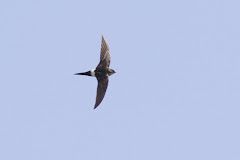

Sunday 27th January started out mild, wet and windy but gradually brightened up into a glorious winter's day with clear skies and a gentle cold northerly breeze. I had planned to go to Dyrhavn to look for woodpeckers and try my luck along the stream at the northern end for the Black-bellied Dippers that have been reported recently. Given the poor weather in the morning I struggled to see much at all. Two drumming Great-spotted Woodpeckers, a few Nuthatches and a Mistle Thrush (not very common here at all in winter) were the highlights of the morning. But the afternoon picked up when I immediately saw one of the Dippers as soon as I reached the stream. For about 15 minutes it fed in the slow moving water, consistently finding light-coloured grubs that seemed to be hiding in leaves at the bottom of the water. Several times,after a short dive, it came to the surface with a rotting leaf which it shook violently to reveal a small grub. It was eventually spooked by a dog which ran to the edge of the stream and flew upstream calling. The Dipper sub-species in Scandinavia is the "Black-bellied" variety, occasionally seen in the east of England, particularly in hard winters. In Denmark, given the lack of uplands and fast-moving streams (the Dipper's favoured breeding habitat), it is almost exclusively a winter visitor, presumably from Norway or Sweden. The UK's version of the Dipper is more reddish-brown below rather than dark brown.
After the Dipper zoomed upstream I wandered to the coast at Charlottenlund to look for gulls. Only a few Black-headed, Common and Herring Gulls loafed on the water but a few hundred yards south a Common Seal was hauled out on a wooden jetty at the local sailing club. It caused quite a lot of interest among the locals and posed very accommodatingly for photographs. Common Seal is, as its name suggests, the most common seal in these parts and it is not unusual for them to be found in small harbours, particularly in winter.














